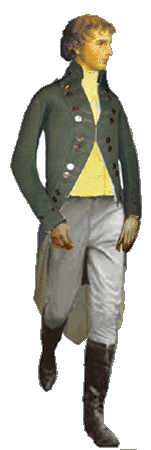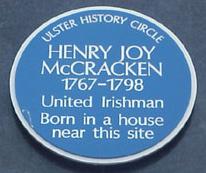|
|
| |
Henry
Joy
McCracken. |
||||
In 1796 the leaders, including Henry Joy and his brother, were arrested and spent fifteen months in Dublin's Kilmainham Jail, When the call to rise to arms came in June 1798, McCracken led the attack on Antrim where they were routed by the army, and he went into hiding. He was arrested near Carrickfergus, tried on the next day .in Belfast, and hanged that evening June 17th 1798 His sister Mary Ann accompanied him from the prison cell to the gallows .outside the Market House in Cornmarket. Mary Ann had a doctor waiting in case the body could be revived. He was buried in the nearby St George’s graveyard, High Street, but the remains were later re-buried in Clifton Street graveyard. See also the United Irishmen, and The 1798 Rebellion in Irish History |
||||
|
Go to famous Irish People home page. |
|
 on
31 August 1767. He was the fifth child of Captain John McCracken,
a Belfast ship owner and rope maker, and Ann Joy, daughter of Francis
Joy, who had founded the Belfast News-Letter and General Advertiser
in 1737.
on
31 August 1767. He was the fifth child of Captain John McCracken,
a Belfast ship owner and rope maker, and Ann Joy, daughter of Francis
Joy, who had founded the Belfast News-Letter and General Advertiser
in 1737. 1791 he was a founder member of the Society of United Irishmen.
and he later was to become a member of the Ulster Directory. In
1795, in the company of
1791 he was a founder member of the Society of United Irishmen.
and he later was to become a member of the Ulster Directory. In
1795, in the company of